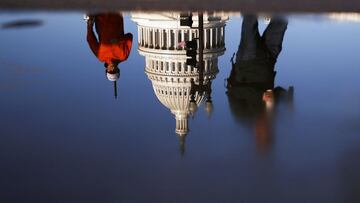New research shows how the stimulus aid was spent and how it helped families
The US Census Bureau used its Household Pulse Survey to study household experiences during the covid-19 pandemic, a recent analysis sheds light on the data.

The coronavirus pandemic caused upheaval in the lives of Americans from coast to coast, and around the world. The US Census Bureau was in a unique position to collect data on the effect of the pandemic on American households through its Household Pulse Survey (HPS).
The US Census Bureau produced the data in collaboration with other federal agencies to aid state and federal authorities in near real-time with the response that was needed and planning for the recovery.
Also see:
- Fourth “stimulus checks” coming in July
- Details begin to emerge on the Senate bipartisan infrastructure bill
- Democrats likely won't pursue extending $300 boost to unemployment benefits
- IRS relaunches online tool for Non-Filers to claim $1,400 stimulus check
Studying the impact of the pandemic and the federal response
The most recent HPS, phase 3.1, started in mid-April 2020 and the results cover a two-week period with a two-day gap between releases. The survey asks millions of US residents the same set of questions relating to their access to food and healthcare, depression and anxiety, ability to make rent and mortgage payments, and more.
A recent Poverty Solutions study from the University of Michigan, using the data collected in the HPS over the past year, examined the impacts the three Economic Impact Payments, or better known as stimulus checks, sent by Congress and found that the additional income helped many keep food on the table and a roof over their head. This in turn reduced anxiety and depression with the most profound effects among low-income households.
Economic benefits of the CARES Act
The researchers found that the benefits passed under the CARES Act in March 2020 helped keep US households afloat until November 2020. These benefits included a $1200 stimulus check and the $600 a week topper in addition to the unemployment insurance (UI) payments provided by the states. Although the additional UI payments were only made until July, there is evidence that families saved these funds and were able to cover their basic needs through November. However, as the year came to an end, the numbers suggest that more households were beginning to show signs of economic distress. These economic indicators captured in the survey, mirrored the worsening health situation the US was facing in late 2020; with infection, hospitalization, and death rate on the rise, businesses closed and finding work became increasingly difficult.
From October to December 2020, the research team found that “among adults with children in the household, food insufficiency increased by nearly 25%.” The marker used to track financial instability also increased by twenty percent over the same period.
Passage of the second and third stimulus bills
Luckily for many households, in December, lawmakers reached a compromise on a new stimulus bill. The December package included a $600 stimulus check and an extension of federal UI benefits worth $300 a week on top of state checks. The data shows that these funds helped bolster the economic resilience of households.
These benefits were enhanced by the passage of the American Rescue Plan, which injected an additional 1.9 trillion dollars into the economy. The Rescue Plan allocated funding for an additional direct payment worth $1,400 (or more for families), extended the $300 topper through September. Additionally, the law also made many changes to the US tax code, including the Child Tax Credit, which made more taxpayers eligible for larger returns this year.
The researchers found that with the passage of these two bills, hardship, as reported by respondents, dropped sharply, particularly among “adults with children, and adults living in households with annual incomes less than $25,000.” The downward trend was seen by those with higher incomes as well.
Food Insecurity
In December 2020, just before the passage of the stimulus bill, food insecurity hit an all-time high. Almost twenty percent of adults with children reported that they “sometimes or often” did not have access to enough food. By April, as households began to receive payments and their incomes grew, that number was cut in half.
Levels of food insecurity were highest among those making less than $25,000 a year, and as to be expected, decreased as income grew. Around Christmas, nearly one third of families with the lowest incomes in the US reported that they lack sufficient access to food. After injecting trillions of dollars in stimulus, these numbers fell to twenty percent in April.
The authors believe that these decreases are, in part, attributable to the sending of direct payments as the move allowed the government to quickly get money in the hands of people that needed it. However, these payments are not occurring, and as we move farther away from when they were sent, rates of insecurity are tipping up. During the most recent survey, thirty-five percent of respondents with children reported that their kids “often or sometimes” went without food.
Former Mayor of Stockton, California @MichaelDTubbs makes the case for a guaranteed basic income after a new study revealed $1,400 stimulus checks substantially reduced economic hardship.#RuhleReports pic.twitter.com/iWPZyODwto
— Stephanie Ruhle Reports (@RuhleOnMSNBC) June 9, 2021
Housing
The federal and state governments have been proactive in taking action to keep people in their homes. Many lawmakers were open to taking extraordinary measures to avoid the eviction and foreclosure rates seen after the 2008 Financial Crisis. Policymakers have provided millions in rental assistance, passed laws to prohibit evictions, and even enacted mortgage forbearance programs. Additionally, enhanced UI benefits and stimulus checks boosted household incomes, making it more feasible to make rent or mortgage payments.
Similar to food insecurity issues, the researchers found in December, before the stimulus legislation was passed, rates of those who reported challenges in making payments for housing hit their peak of ten percent (15 percent for those with children). The data showed a minor increase before the American Rescue Plan was passed, but overall, the rates declined to seven percent in April (ten percent for those with children).
However, the May results show that these numbers are rising quickly. The HPS asks what the likelihood is that respondents are evicted or foreclosed on in the next two months, and results from May show economic stress is being felt. Twenty percent of homeowners reported that foreclosure was “very or somewhat likely.” Numbers from the rental market are even more concerning as over forty percent, one in four households, reported that eviction is likely in the next two months. Also, the rate of people reporting that they are behind on the mortgage, eleven percent, or rent, fourteen percent, payments have increased past their April average of ten percent.
These numbers alarm housing experts who worry of a tsunami of evictions will occur if the eviction moratorium, which is set to end 30 June, is not extended.
Mental Well-Being
The sending of direct payments also correlated with quick drops in the percent of respondents who reported feeling depressed or anxious. The HPS is unique in that it is able to quantify a variable many in the social sciences often struggle to find, suffering. The results are emblematic of the devastating toll the pandemic has had on those in the US. More than half a million people have died -- parents, friends, co-workers, neighbors. The nation experienced a mass casualty event; the trauma, and its lasting impacts it will have, are yet to be understood.
To gauge the mental health of those in the HPS includes questions relating to anxiety and depression, including: “Over the last seven days, how often have you been bothered by the following problems…
- Feeling nervous, anxious, or on edge? (anxiety)
- Not being able to stop or control worrying? (anxiety)
- Having little interest or pleasure in doing things? (depression)
- Feeling down, depressed, or hopeless? (depression).”
In late 2020 as economic conditions worsened for many households, the average of respondents who reported feelings of anxiety peeked at sixty-four percent. The figures for the symptoms of depression were just as alarming, with over half of survey respondents showing signs. In their analysis, the researchers reported that the well-being of US households often either improved or declined in relation “to the level of government support.”
As the stimulus checks and other economic benefits began to arrive, these numbers, especially for those with children, began to decline. By May, these figures had decreased by twenty percent.
Stimulus Checks Substantially Reduced Hardship, Study Shows
— Brian Deese (@BrianDeeseNEC) June 2, 2021
"Among households with children, reports of food shortages fell 42 percent from January through April. A broader gauge of financial instability fell 43 percent."https://t.co/ZZQnpaLGma
Additionally, these numbers are very high relative to the rates of various mental illnesses estimated in the United States. The Anxiety and Depression Association estimates the following rates of anxiety and depression disorders within the US population:
- Generalized Anxiety Disorder (GAD): 3.1%
- Panic Disorder: 2.7%
- Social Anxiety Disorder: 6.8%
- Major Depressive Disorder: 6.7 %
- Persistent depressive disorder: 1.5%.
Related stories
While these are just estimates and it is possible for individuals to suffer symptoms without clinical diagnosis, the numbers reported in the survey are pretty high compared to these figures. Since the Census Bureau began administering the survey, the rate of those reporting symptoms of anxiety and depression has never fallen below forty or fifty percent, respectively. When it comes to seeking help, numbers are low. In May, only ten percent of all respondents reported that they had “received counseling or therapy from a mental health professional such as a psychiatrist, psychologist, psychiatric nurse, or clinical social worker.” Rates of seeking help were highest for those between 18-29 and those making less than $25,000 a year.
Final takeaways
These findings have been touted by Democrats who passed the American Rescue Plan with zero support from Republicans. The GOP has been relatively quiet on the results and has continued with its plans to end federal UI benefits in many states. Republicans have also voiced concerns that passing more stimulus would hurt the economy by raising inflation or by incentivizing workers to stay home rather than renter the labor force. A growing number of Democrats now support sending a fourth -- and even fifth -- stimulus payment, and after the May jobs numbers are announced tomorrow, there may be developments on that debate.
- Census
- Household income
- Coronavirus stimulus checks
- USA coronavirus stimulus checks
- Covid-19 economic crisis
- Science
- Coronavirus Covid-19
- Economic crisis
- Home economics
- United States
- Pandemic
- Coronavirus
- Recession
- North America
- Economic climate
- Virology
- Outbreak
- Infectious diseases
- Diseases
- Microbiology
- Demography
- America
- Medicine
- Economy
- Society
- Life sciences
- Health

